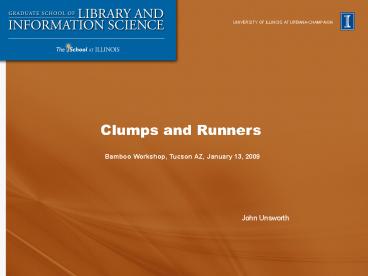Clumps and Runners - PowerPoint PPT Presentation
1 / 11
Title:
Clumps and Runners
Description:
It can also be important to recognize the difference between the main text of a work (the ... to maps to architecture, landscape, ... PowerPoint Presentation ... – PowerPoint PPT presentation
Number of Views:103
Avg rating:3.0/5.0
Title: Clumps and Runners
1
Clumps and Runners
Bamboo Workshop, Tucson AZ, January 13, 2009
John Unsworth
2
Exchange of ideas
- A substantial amount of the work of the
humanities is carried out in the form of the
exchange of ideas. -- Anthony Cascardi - No ideas but in things -- William Carlos
Williams
3
Things in the humanities
- the whole variety of material cultural heritage,
from images to sound to text to maps to
architecture, landscape, and all manner of
carrier media ... including sheep DNA in
parchment.
4
Representing things
- ... a problem usually discussed at a high level
of abstraction, in digital humanities. I'd like
to discuss it at a very prosaic level, instead,
with text objects as the example.
5
TEI
- "The Text Encoding Initiative Consortium is an
international organization whose mission is to
develop and maintain guidelines for the digital
encoding of literary and linguistic texts. The
Consortium publishes the Text Encoding Initiative
Guidelines for Electronic Text Encoding and
Interchange an international and
interdisciplinary standard that is widely used by
libraries, museums, publishers, and individual
scholars to represent all kinds of textual
material for online research and teaching." - http//www.tei-c.org/About/index.xml
6
Lessons of Google?
- But why do any mark-up at all? Isn't the lesson
of Google that all that really matters is the
word, and tagging is superfluous? Not if you want
to select out of Google Books - Fiction
- Books about England
- Books published in the 1900s
- Books written by women
7
But structural markup? Really?
- It turns out that, more often than not,
paragraphs and chapters, lines and verses, are
meaningful units of composition, and therefore
they can be meaningful units of analysis. It can
also be important to recognize the difference
between the main text of a work (the chapters in
a novel, say) and the paratext (table of
contents, preface, running headers, etc.),
especially if you're asking statistical questions
about the text.
8
Surely we don't need to mess with the words,
though...
- ... at the word level, it can be helpful (in a
novel, for example) to ignore proper names, for
example, so as to see more clearly what's going
on with other kinds of words--but even at the
word level, the information about the words is
carried, ultimately, in tagging.
9
Interoperability
- The TEI community believes. . . that "people use
TEI in many different contexts for many different
purposes to encode many different kinds of
material." But they also believe that this
somehow, in some universe, achieves the TEI's
stated goal of interoperability. It really
doesn't. So if people are in fact encoding
things in all sorts of different ways and for
different purposes, then why shouldn't I chuck it
all and roll my own? You say that's it better
not to go it alone. - (Steve Ramsay, in email)?
10
Interoperability?
- As we are coming to the end of this project --
and returning to an earlier exchange of views on
the Monk list about interoperable texts-- I can't
refrain from pointing to the large amount of
needless and heedless divergence. There is good
and bad news about it. The bad news is that it
has caused a lot of work. The good news is that a
very high percentage of problems can be solved
quite satisfactorily by supplementary conventions
to the content rules of elements. If, for
instance, the people who slapped the Level 4
Guidelines together had spent two hours about
making recommendations what to do or not to do
about soft hyphens at the end of a line or page
when you encode a text according to Level 4
Guidelines, we'd have a lot less grief. And so it
goes with a lot of other little stuff. - (Martin Mueller, in email)?
11
Clumps and Runners
- So, we have data in clumpsin collections that
are curated and hosted by libraries, publishers,
and others what we need are the runners that
connect those clumps, and what we'll discover
when we have them is that data doesn't move
between clumps very successfully. That's a
problem that nobody is really dealing with, and
that's a role for Bamboo. I'm not recommending
that Bamboo become a standards group, but rather
that Bamboo attend to the actual problems of data
interchange and interoperability, in actual data
domains, for actual research projects, and that
it collect and synthesize the experience of
actual practice and turn it back to the stewards
of content, to reduce needless and heedless
divergence.































